Skepticblog
About Donald Prothero

Donald R. Prothero was Professor of Geology at Occidental College in Los Angeles, and Lecturer in Geobiology at the California Institute of Technology in Pasadena. He earned M.A., M.Phil., and Ph.D. degrees in geological sciences from Columbia University in 1982, and a B.A. in geology and biology (highest honors, Phi Beta Kappa) from the University of California, Riverside. He is currently the author, co-author, editor, or co-editor of 28 books and over 250 scientific papers, including five leading geology textbooks and four trade books as well as edited symposium volumes and other technical works. He is on the editorial board of Skeptic magazine, and in the past has served as an associate or technical editor for Geology, Paleobiology and Journal of Paleontology. He is a Fellow of the Geological Society of America, the Paleontological Society, and the Linnaean Society of London, and has also received fellowships from the Guggenheim Foundation and the National Science Foundation. He has served as the President and Vice President of the Pacific Section of SEPM (Society of Sedimentary Geology), and five years as the Program Chair for the Society of Vertebrate Paleontology. In 1991, he received the Schuchert Award of the Paleontological Society for the outstanding paleontologist under the age of 40. He has also been featured on several television documentaries, including episodes of Paleoworld (BBC), Prehistoric Monsters Revealed (History Channel), Entelodon and Hyaenodon (National Geographic Channel) and Walking with Prehistoric Beasts (BBC).
RSS feed for this authorfaculty.oxy.edu/prothero
Subjects
aliens alternative medicine atheism autism belief bigfoot Brian Dunning CAM Carl Sagan climate change conspiracy theories Creation creationism critical thinking cryptozoology denialism dinosaurs Dr. Kiki earthquakes economics education environment ethics evolution fossils geology Ghost Hunting ghosts global warming God homeopathy intelligent design james randi journalism media medicine michael shermer morality nasa paleontology paranormal politics pseudoscience Psychics psychology religion science science denialism scope SETI Shermer skeptical history skepticism skeptoid Skeptologists TV ufo ufos vaccines videoRecent Comments
- Daniel Loxton commented on A Fond Farewell to Skepticblog at 1:25 pm, September 18, 2014
- markx commented on A Fond Farewell to Skepticblog at 8:52 pm, September 17, 2014
- Thomas commented on False Equivalence at 11:44 am, September 15, 2014
- John Greg commented on A Fond Farewell to Skepticblog at 2:10 pm, September 13, 2014
- tmac57 commented on A Fond Farewell to Skepticblog at 10:39 am, September 13, 2014
Read posts by author:
Unpersuadable—and unscientific
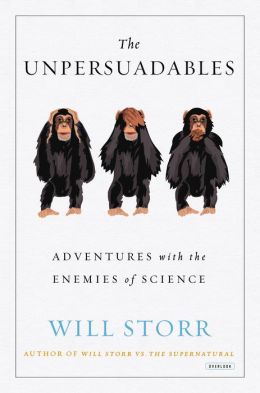
A review of The Unpersuadables: Adventures with the Enemies of Science, by Will Storr (2014, Overlook Press, New York).
Most of us long-term skeptics have had our share of run-ins with people who cling stubbornly to a particular dogma. We get frustrated that no amount of evidence or strong arguments ever changes their point of view. The pattern is true whether you’re dealing with religious beliefs (from creationism to various Eastern religious ideas), or paranormal beliefs (UFO nuts, psychics, ghosts, cryptozoology) or just plain pseudoscience and bad scholarship (homeopathy, past-life regression, Holocaust deniers, climate-change deniers, and many others). Reporter Will Storr decided to go deep into the heart of these various fringe and non-scientific belief systems, interviewing the major figures, taking part in their rituals, and doing his best to give them a fair shake as he embeds himself into their culture. (continue reading…)
comments (10)From the ashes of disaster grow the roses of success
Every great improvement has come after repeated failures. Virtually nothing comes out right the first time. Failures, repeated failures, are finger posts on the road to achievement. One fails forward toward success.
—Charles Kettering
Honorable errors do not count as failures in science, but as seeds for progress in the quintessential activity of correction.
—Stephen Jay Gould
Most people hear only about the successful experiments in science. What is usually not reported is the fact that for every scientific success, there may be numerous failures and false leads and blind alleys. Most people would find this discouraging, but scientists learn early in their careers that one has to expect a number of failed experiments that can lead us to better ideas. As philosophers of science pointed out long ago, science is about testing and falsifying hypotheses. No number of positive or consistent observations can ever prove a statement true (e.g., “all swans are white”) but a single contradictory observation (e.g., the Australian black swan) can easily prove the statement false. Likewise, every failed experiment points the scientist toward a new direction or a new hypothesis or new experiment, which may eventually prove fruitful. Science is a process of trial and error, and scientists need patience, persistence and determination to reach good results after many letdowns.
Nearly every field in science can point to examples of this. Even after 35 years of doing magnetic stratigraphy, not every locality where I have done paleomagnetic sampling produced good results. The data from those unsuccessful studies are sitting in my file cabinets and the hard drive of the lab computer, but I won’t bother working on them further or try to report them in a publication. Occasionally, I’ll mention in print that a particular area (like the Chadron Formation in the Big Badlands, or the Titus Canyon Formation near Death Valley) produced no good paleomagnetic results, but further discussion is usually not worth writing up.
Likewise, looking for vertebrate fossils is usually a frustrating and unsuccessful exercise. Most paleontologists must spend days or weeks in a field to find anything, and sometimes several field seasons can go by with no worthwhile results. My graduate advisor Malcolm McKenna spent several years collecting his dissertation area at Four Mile Creek in northwestern Colorado before finding good specimens. Louis and Mary Leakey spent decades collecting in Olduvai Gorge, Tanzania, and found plenty of Pliocene-Pleistocene pigs and antelopes and elephants, but not a signal human fossil until their remarkable find of “Zinjanthropus” (now Paranthropus) boisei in 1959. But if paleontologists were not so determined and dedicated, there would be few fossils in museums for us to study.
comments (2)Ken Ham’s ark is going down, going down, going down…
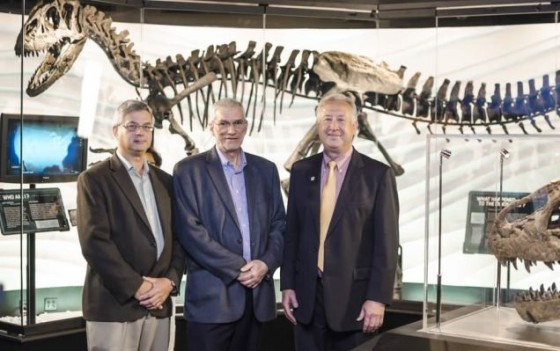
The allosaur “Ebenezer” with “geologist” Andrew Snelling, Ken Ham, and racist Michael Peroutka, the donor
There’s a sucker born every minute.
—Attributed to P.T. Barnum
The crazy story of Ken Ham’s Answers in Genesis organization and their ambitious plans keeps getting stranger and stranger. Just a few weeks ago, Ham crowed about having a real Allosaurus skeleton (nicknamed Ebenezer) on display in his Creation “Museum”—a sad loss of an important specimen to science. Not only will it have no sound scientific data to accompany it, but instead it’s going to have the weird pseudoscience of creationist “flood geology” used to interpret it, and provides the creationists with something to brag about. The Creation “Museum” is having their resident “flood geologist” Andrew Snelling study the specimen—even though he doesn’t have any training in paleontology, doesn’t know one bone from another, and obtained his only legitimate training in uranium geology. As blogger Artiofab discovered, the collection was done on a ranch in Colorado by a bunch of creationist students and home-schoolers, and no one with legitimate training in paleontology, taphonomy or sedimentary geology involved or collecting proper data—just “flood geologists” with their distorted view of the geologic record.
As blogger Artiofab commented:
comments (39)As you can see from photographs of Ebenezer, this specimen no longer has its original preservation; each skeletal element has been prepared out of matrix, presumably during the more than ten years that its private owners had access to it. Have samples of the matrix been saved for future geochemical work on the depositional environment of Ebenezer? If not, then this data is gone, and Ebenezer is devoid of environmental data.Without information from the Creation “Museum”, I have no way of knowing how data-deficient Ebenezer is. Ebenezer could have field notes, photographs of the excavation, and rock matrix samples stored away somewhere. If Ebenezer has these things, then Ebenezer is useful to science. If Ebenezer does not, then Ebenezer is useless scientifically.
“COSMOS” concludes
Ep 1 of Cosmos, “Waking Up in the Milky Way” aired 14 weeks ago. Those TV signals are now entering the Oort Cloud of comets.
-Neil deGrasse Tyson
After 14 weeks, “Cosmos” has finally aired all its original 13 episodes (with one week off on Memorial Day weekend). Now that it’s over, we can step back and assess it for its intrinsic value, and also for its possible effects on culture.
When Episode 1 first aired, there were a mix of reactions. Most of us were overwhelmingly positive about what we saw in the first episode, with the state-of-the art special effects as they tour the universe contrasted with the deliberately crude animations that portray historical figures and events. There were a lot of nitpickers who were horrified about the small scientific errors in the first episode. True, there should be no sound in the vacuum of space, and the asteroid belt or the Oort cloud are not as tightly packed with objects as the animation suggests. But most reviewers regarded those things as minor errors which don’t detract from the overall message, and are only noticeable to the relevant experts. The nitpickers missing the point: Modern lay audiences, conditioned by generations of sci-fi movies with dense clusters of objects and sound in space, wouldn’t even know how to comprehend something which was TOO accurate. Personally, I would have liked to have seen them be more careful about particular geological and paleontological details. I cringed when they put Early Permian Dimetrodon in the landscape of the Late Permian extinction, and other prehistoric anachronisms; I wish someone had coached them to pronounce Bruce Heezen’s name properly (HAY-zen, NOT HEE-zen); I wish they had presented a more pluralistic and accurate account of the Cretaceous extinctions, instead of the simplistic “asteroid did it—end of story” version so popular in the media, but not supported by the evidence. (continue reading…)
comments (15)The legacy of the Exxon Valdez disaster
Last March was the 25th anniversary of one of the worst environmental disasters in U.S. history: the Exxon Valdez oil spill. It was such a huge leak that it permanently changed the policies of the U.S. Government about shipping oil in U.S. waters, and changed the attitude of many Americans about the risks of huge, hard-to-maneuver supertankers operating in close to shore. More importantly, it galvanized the environmental movement for many years, and forced many Americans to reassess our voracious consumption of oil (even though this was Alaskan oil, not foreign oil). Among U.S. oil spills, only the 2010 BP Deepwater Horizon oil spill was worse in terms of total amount of oil leaked into the ocean.
The facts of the disaster are mostly straightforward. Near midnight on March 24, 1989, the gigantic oil tanker Exxon Valdez was carrying 55 million gallons of crude oil, pumped from up in Prudhoe Bay, Alaska, and then shipped from Valdez Harbor, on its way to Long Beach, California. As it was maneuvering through the rocky waters of Prince William Sound, only the third mate was awake and in control of the ship, and he was sleep-deprived. At 12:04 a.m. in the dead of night, the ship hit Bligh Reef, tore a huge hole in the hull, and immediately began leaking hundreds of barrels of oil. (continue reading…)
comments (8)How many real creationists are there?
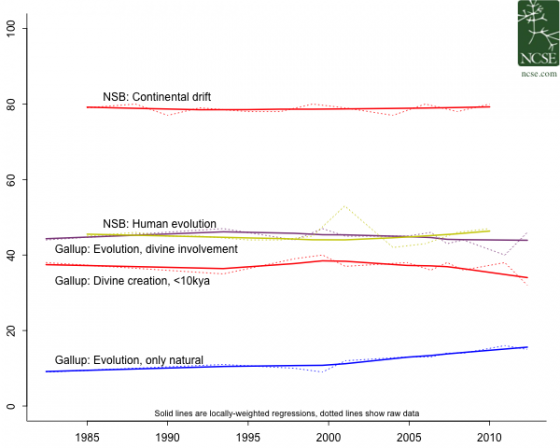
When you break down the polls and question Americans about their acceptance of specific scientific ideas like continental drift and animal evolution, a much higher percentage are NOT creationists
For decades now, the Gallup Poll has surveyed Americans about their belief in evolution and creation. Year in and year out, the numbers seem to remain constant: about 40-45% of Americans appear to be Young-Earth creationists (YEC). The exact phrasing of the question is as follows:
Which of the following statements comes closest to your views on the origin and development of human beings: human beings have evolved over millions of years from other forms of life and God guided this process, human beings have evolved over millions of years from other forms of life, but God had no part in this process, or God created human beings in their present form at one time within the last 10,000 years.
For decades about 44% of the respondents agree to the last answer (YEC), another 37% chose the first answer (theistic evolution, ID creationist), and only 12% favor the second answer (non-theistic evolution). Gallup wrote these questions decades ago before there was much understanding of how the framing of a question can bias the answer, and for decades, they have kept the question the same so comparisons remain consistent. But social scientists know that polls can be very misleading, especially in the way the question is framed to force certain responses. For example, the Gallup poll only gives us three possibilities, and load two of the answers with “God”, which is an obvious bias right from the start. In addition, there is good evidence to suggest that human evolution is the real sticking point, and that most people don’t care one way or another if non-human creatures evolve or not. What if we asked people what they thought about specific scientific ideas, independent of emotional issues like “God” and “humans”?
comments (26)Holly-weird science
As I wind down the semester teaching six different classes in introductory geology and oceanography at three different colleges, I’ve found myself explaining in nearly every lecture the difference between the real world and the popular mythology that appears in the movies, television, and the cartoons. Since nearly everything the general public thinks they know about science seems to come from bad Hollywood movies and TV shows, it’s not surprising that these myths are perpetuated, and our scientific literacy is so abysmal.
This is not a new topic, of course. Physicists and astronomers have long complained how badly most sci fi movies and TV and novels mangle science (starting with the impossibility of transmitting sound in the vacuum of space, which nearly all the space movies get wrong—but explosions without sound simply don’t do it for today’s audiences). I know of some geology departments that have “Bad geology movie” nights, where they play older films and laugh at all the ridiculous things they say about the earth. (In fact, nearly every Hollywood movie gets the geology all wrong). But I’ve been a scientist since I was hooked on dinosaurs at age 4, and consequently I’ve never enjoyed movies that distort or violate the rules of science. Websites like TVtropes.org document the wide range of stupid or silly things that show up regularly in movies or TV, and how little reality or science influences the decisions of scriptwriters. Of course, this is basic Scriptwriting 101: the story arc of the plot, the development and interaction of characters, and many other things take priority over keeping the movie within the bounds of scientific reality. I’ve been a scientific consultant on enough shows to know that what I say is only a guideline, and the story and characters take precedence over reality. Still, in many or most cases, the movie plot would work just fine with a realistic portrayal of science, but that rarely happens. After all, screen writers tend to be no more literate about science than their audiences, so to a large extent they don’t know that all these cliched ideas are false—and most don’t seem to care, even if it is explained to them. As TVtropes.org puts it, it’s the “Rule of Cool”: audiences will forgive gross scientific inaccuracies and completely implausible action if it makes the movie more spectacular and enjoyable. (continue reading…)
comments (22)The woman who saw beneath oceans
Soundings: The Story of the Remarkable Woman Who Mapped the Ocean Floor by Hali Felt (Henry Holt & Co., New York, 2012)
For almost 70 years we have seen the large maps and globes showing the topography of the world’s oceans and continents, and taken them for granted. The map of the world’s land topography was a hard-won accomplishment made by generations of surveyors and cartographers, gradually improved and refined during the golden ages of exploration in the 1700s and 1800s. But before 1957, over 70% of the earth’s surface was simply unknown. Maps of the world’s oceans showed a few islands on a patch of solid blue, and not much else. Whatever was beneath the ocean’s surface was terra incognita. For the longest time, people thought that trilobites still roamed the seafloor, or that the entire seafloor was a flat featureless plain. Surprisingly, virtually all of the undersea world we now take for granted was mapped by one person! Even more remarkably, that person was a woman in an age where women had few opportunities in science. And sadly, despite the fact that she mapped more of our planet’s surface than any other person in history, her name is virtually unknown except to a few scientists. Fortunately, with the May 4 episode of “Cosmos” that just aired, her name is getting a bit more publicity.
Her name was Marie Tharp, and I was fortunate to meet her and her longtime scientific and romantic partner Bruce Heezen (pronounced HAY-zen) when I was still a graduate student at Lamont-Doherty Geological Observatory in the late 1970s. (Sadly, “Cosmos” mispronounced Heezen they way most people mispronounce it). Writer Hali Felt has produced a very enjoyable biography of this groundbreaking but underappreciated giant in the sciences of geology and geography. She was born in Ypsilanti, Michigan, on July 30, 1920, but she grew up in many different states, and followed a nearly rootless existence, because her father William made soil classification maps for many different state surveys. Always the new kid in town, she seldom made friends in school, but she was very bright and hardworking and did very well in her studies. As she got older, she spent a lot of time riding around with her father helping him in his work, so she learned about geology and natural history and mapping and surveying at a young age. She graduated from Ohio University in 1943 with majors in English and music and four minors. Then she got a master’s in geology at the University of Michigan at time when few women were allowed in geology, but wartime shortages of male students needed for the oil industry opened the door for her. For a while she worked at Stanolind Oil in Tulsa, Oklahoma, earning another degree in Mathematics at the University of Tulsa as she worked. (continue reading…)
comments (3)Oarfish and Earthquake Myths
Last fall, there was a big buzz across the internet when two rare events happened just five days apart: the stranding of two dead oarfish on southern California beaches. On Oct. 13, an 18-footer was found on Catalina Island, and on Oct. 18, a 14-footer was found on the beach in Oceanside. The oarfish is an amazing-looking sea creature, with a long, flat, serpentine body, a long dorsal fin along the entire length of its body, and tiny spine-like pectoral and pelvic fins. It is thought to have been the source of some of the “sea serpent” legends, since large specimens can be up to 50 feet (15 m) long. The fact that two such strandings had happened so closely in time generated most of the buzz, since strandings are normally rare, with one or two a year at most. Once in awhile there are accidental sightings of oarfish which are apparently trying to beach themselves, such as shown in this remarkable footage.
The biggest buzz, however, was not about the unusual occurrence of two strandings in five days, but about some Japanese legend that claims that oarfish strandings predict earthquakes. This ridiculous idea managed to get coverage on a wide variety of news sites and websites, including the BBC, with almost no mention of any scientist debunking it. As usual, the credulous media ran with the story for days and not once did you hear the slightest bit of skepticism (except maybe a passing sentence or two from some biologist or geologist). (continue reading…)
comments (6)Hosted by Skeptic magazine. For website-related matters, contact the webmaster.

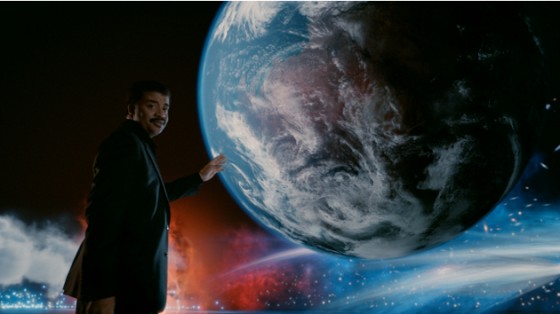
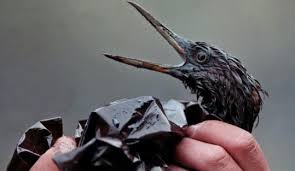
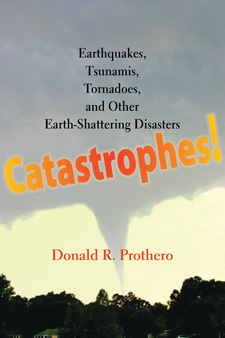

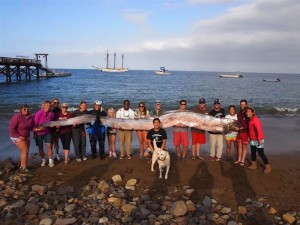
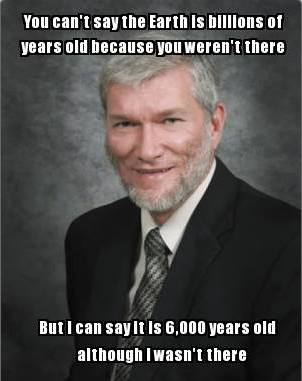
comments (18)I am leaving for The Amazing Meeting this morning (I speak at 11:00 on Sunday, if you’re attending), but I had dinner with Bill Nye last night (who is a keynote speaker at TAM). We got to talking about his victory over Ken Ham in the debate last February 4. The week before the debate, both the NCSE and Michael Shermer and I had helped coach him on what to expect and how to approach the event. During our session at Shermer’s house, Bill was especially interested in having me explain how radiometric dating worked, and how to handle creationist lies about it. In the debate, Bill did the smart thing and give example after example of clear-cut things that demonstrated the earth was older than 6000 years: tree rings and the oldest trees, ice cores that have 680,000 continuous seasonal bands recorded in them, objects that are hundreds to millions of light-years away, etc. However, he was stumped when Ham dragged out a long-debunked creationist trope about a volcanic lava in Australia dated at 45 m.y. which surrounded trees which were radiocarbon dated at 40,000 years old. In such a short coaching session, it was not possible to explain to him about every creationist distortion of radiometric dating. Luckily, the example slipped past the attention of the audience quickly, and made no difference in the long run (nor did any specific point—as I said before, the debate was about perception and winning “hearts and minds”). (continue reading…)